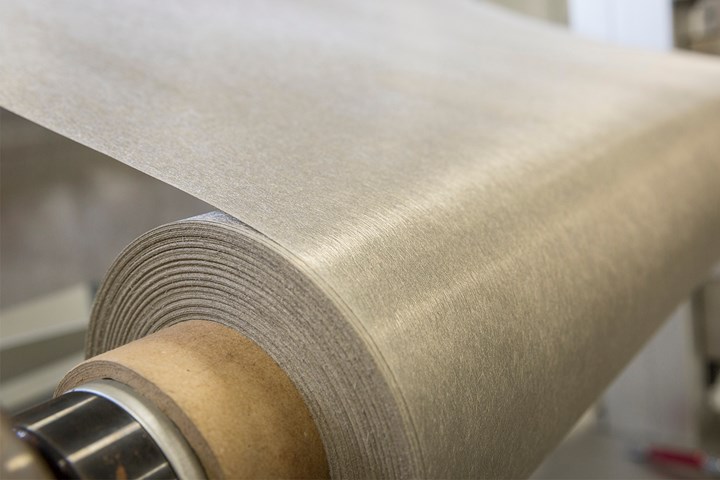Veelo Technologies increases metallized nonwoven conductivity
Lowered resistivity from 5-10 mOHM to 3 mOHM with a 10% weight penalty improves conductivity of metallized nonwoven VeeloVEIL.

Photo Credit: Veelo Technologies
Veelo Technologies (Cincinnati, Ohio, U.S.) has recently improved the conductivity of its VeeloVEIL, a metallized nonwoven advanced material, which is now available in 3 mOHM/sq, 55 g/m2, with less than 5% electrical uniformity in a 36-inch-wide continuous product form. The lower resistivity is a noticeable departure from Veelo report in CW’s September 2019 plant tour, which states that VeeloVEIL was engineered to deliver 5-10 milliohms of electrical resistivity at an areal weight of 40-50 g/m2. Veelo adds that the new offering has set a new standard in the high-growth aerospace and defense composites protection market.
According to Veelo Technologies, at 3 mOHM/sq, VeeloVEIL offers twice the specific conductivity of expanded copper foil at 195 g/m2, and 7-150 times better performance than other available metallized nonwovens. Additionally, VeeloVEIL is said to provide superior EMI shielding effectiveness, and is reported by Veelo to be one of only a few products to meet the aerospace and defense industry’s most stringent Zone 1A Lightning Strike Protection requirement.
According to Larry Christy, director of Research and Development at Veelo Technologies, VeeloVEIL is a light, highly conductive and electrically uniform material designed to protect composite air vehicles from electromagnetic effects as well as lighting strikes. The expansion of Veelo’s product capacity to a 36-inch continuous form also enables VeeloVEIL to be used in a wider variety of applications.
VeeloVEIL is available with tailored resistivities from 3-40 mOHM/sq and basis weights from 20-55 grams/m2. It is available in dry reinforcement, film adhesive or surfacing film.
Related Content
-
Plant tour: Airbus, Illescas, Spain
Airbus’ Illescas facility, featuring highly automated composites processes for the A350 lower wing cover and one-piece Section 19 fuselage barrels, works toward production ramp-ups and next-generation aircraft.
-
Combining multifunctional thermoplastic composites, additive manufacturing for next-gen airframe structures
The DOMMINIO project combines AFP with 3D printed gyroid cores, embedded SHM sensors and smart materials for induction-driven disassembly of parts at end of life.
-
First Airbus A350 crash confirmed in Haneda
Shortly after touch-down, a JAL A350-900 aircraft recently collided with a De Havilland Canada Dash 8. Exact circumstances are still unknown.



